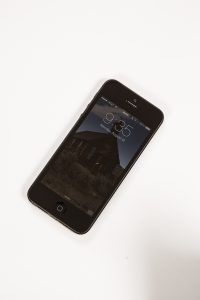Technology has had a profound impact on our society in an amazingly short amount of time. All human history considered, the Internet is really just a toddler, and the iPhone is still a newborn. Yet, they have succeeded in infiltrating almost every aspect of our world within a tiny blip on mankind’s timeline.
The old sci-fi books of the twentieth century predicted computers would take over our world, and they have … just not in the manic, artificially-intelligent, destructive way they had originally depicted. Instead, the tantalizing speed and efficiency of computers now touches nearly every product or service we utilize on a daily basis. In fact, the wheels of society would almost grind to a halt if computers suddenly ceased to exist.
Functionally, we are learning and evolving at a dizzying pace and our productivity is tipping the scales of history. Communications are instant, 24-hour and global. And with social media, the world has suddenly become a paradoxical stage where anyone can be front and center, and yet, still behind a curtain.
Just like a scientist might observe changes in a laboratory experiment, we can now see how technology is changing our behavior. On one hand, we can fit more tasks into our day, plan a vacation within an hour and cook food in minutes. On the other hand, social and emotional issues related to technology have reached an epidemic scale.
The first iPhone was released on June 29, 2007, and by 2015, according to Pew Research Center, 73 percent of teens had access to smart phones. It was a product uptake dream, but the social media apps that followed have changed the social scene dramatically. While creating a means to quickly rally support for those in need, raise awareness and encourage others, these apps have also started a comparison game, which has led to a pageantry of vanity, record levels of depression and a collective fear of missing out (FOMO).
In 2015, a documentary entitled “#Being 13: Inside the Secret World of Teens” aired on CNN, summarizing a two-year study by a team of two professors, including University of Texas at Dallas dean of graduate studies and professor of psychological sciences Dr. Marion Underwood and University of California Davis associate professor of sociology, Dr. Robert Faris. This study focused on 200 eighth-graders in schools across the country to understand their usage of social media. After observing all social media interactions for six months, they discovered it was not unusual for some teens to check their phones more than 100 times a day, a behavior experts call “lurking” (viewing social media feeds without posting). The study found a correlation between lurking and increased stress levels among teenagers. If you are a part of a teenager’s or upcoming teenager’s life, the 43-minute documentary is an eye-opening and educational must-see.
According to the National Center for Health Research, “One psychology professor at San Diego State University discovered that teens who spend five or more hours a day online were 71 percent more likely to have at least one risk factor for suicide compared to teens who spent only one hour a day online.”
Another study, conducted by Melissa G. Hunt and published in 2018 in the Journal of Social and Clinical Psychology, found that limiting social media to 30 minutes a day resulted in significant reductions in loneliness and depression. Ask any middle school or high school counselor about social media, and they will be quick to tell you their thoughts on bullying, depression and more. They have seen the worst of it.
It only takes a few minutes at a local restaurant or at the mall to see how technology has changed everyone’s social interaction. Thankfully, a group of local teens has seen the effects and they are taking strides to increase awareness and have a positive impact.
“It just makes us sad that we are taking technology for granted, and we are not really using it for the right purposes,” says David Moon, a senior at Centennial High School and co-founder of the nonprofit organization Disconnect 2 Connect (D2C). “When you walk into a restaurant, you can see an entire family looking down at their phones texting. Or, when you go to school, people are using their devices to cheat all the time. They are using technology for the wrong reasons. So, we wanted to bring it back to a time when technology, like a typewriter, was used for what it is meant for and nothing else.”
 D2C strives to tackle both sides of the technological coin: encouraging those with technology addiction to break free while helping those who are economically disadvantaged learn the benefits of technology. Both efforts work toward the common goals of breaking down the invisible barriers of technology and creating a stronger social network and community. “I hope we can help the next generation live their lives with technology, not being controlled by it,” says Pranesh Satish, the co-founder of D2C and a high school senior at the Texas Academy of Mathematics and Science (TAMS) at the University of North Texas.
D2C strives to tackle both sides of the technological coin: encouraging those with technology addiction to break free while helping those who are economically disadvantaged learn the benefits of technology. Both efforts work toward the common goals of breaking down the invisible barriers of technology and creating a stronger social network and community. “I hope we can help the next generation live their lives with technology, not being controlled by it,” says Pranesh Satish, the co-founder of D2C and a high school senior at the Texas Academy of Mathematics and Science (TAMS) at the University of North Texas.
D2C’s third executive director and a senior at Centennial High School, Brian Lee, says, “Technology has endowed some of my best friends with a possible major, a career and a passion. It has also given others a new, uncontrollable addiction.” Mr. Lee admits he once spent the majority of his free time watching YouTube or playing video games, but says, “It is absolutely fine to check social media or play video games once in a while. The problem that is so pervasive in society is when you allow your life online to dictate your life offline.” He adds, “The best thing to do with time that would be otherwise wasted is to give it up in the service of others. In this way, we hope to leave a positive impact on our community.”
So, Mr. Moon, with his passion for neuroscience and playing the harp, Mr. Lee who enjoys cardistry, debating and playing the violin and Mr. Satish, who loves computer engineering, sports and dancing hip hop, joined forces with six other high school students across Plano and Frisco to start a campaign for their cause and conduct workshops at various businesses in the area.
Their social media posts, including Motivational Monday, Tech Tip Tuesday and Fun Fact Friday, appear on Facebook and Instagram to give quick tips on how to use technology and combat addiction. One suggestion, Mr. Lee says, is to “use technology against itself by downloading applications that help you limit the time you spend on certain applications.”
Their free workshops have been conducted at Intuit, Girls, Inc., Bright Academy, Genesis Women’s Shelter and more. D2C is currently seeking 501(c)(3) status so they can start accepting donations to purchase devices for training purposes during their workshops. Occasionally, D2C has to turn down workshop requests from underfunded clients due to lack of enough devices.
But a favorite moment for Mr. Satish was seeing a tech company, Intuit, embrace D2C’s initiative, and Mr. Moon says it has been “really moving to see how collaborative people can be when there is not a screen in between them.”
Interested in joining the cause? Check out disconnect2connect.us and get involved. This could be just the program your child or teen needs to help make an impactful, positive difference in how they spend their time and prioritize their life. “Do not be afraid of the future,” Mr. Satish says. “Technology may seem scary to some, but technology does not control you. You control it.”


